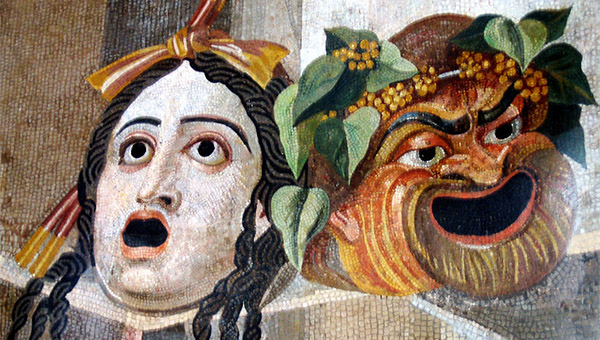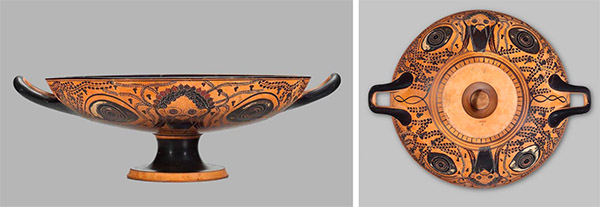THE MEANINGS OF MASKS
Persona: Masks in the Graeco-Roman World | Stephanie Ann Frampton

Stephanie Ann Frampton at work; photo by Catie Newell
"In Latin, one of the words for mask is persona, thought to have meant 'something through which sound passes' (per- 'through,' sono 'to make a sound'). Even in the time of Cicero, persona was already being used to describe the 'part' or 'character that one sustains in the world' — in other words, the role or roles we play in society."
— Stephanie Frampton, Associate Professor of Classical Literature, and faculty director, MIT Programs in Digital Humanities
SERIES | THE MEANINGS OF MASKS
As The Washington Post has reported, "at the heart of the dismal US coronavirus response" is a "fraught relationship with masks." With this series of commentaries — inspired by ideas from literature professor Sandy Alexandre — MIT faculty explore the myriad historic, creative, and cultural meanings of masks to offer more ways to think about, appreciate, and practice protective masking — currently a primary way to contain the Covid-19 pandemic.
Stephanie Ann Frampton is an associate professor of classical literature at MIT, where she serves as co-chair of Ancient and Medieval Studies and faculty director of the Programs in Digital Humanities. Her work explores the intersections of material and literary culture in the ancient Mediterranean and focuses on the classical tradition, particularly histories of the book, writing, reading, and scholarly practice. She is the author of Empire of Letters: Writing in Roman Literature and Thought from Lucretius to Ovid (Oxford University Press, 2019). SHASS Communications spoke with her in late August 2020.
• • •
Q: Humans use masks for a variety of purposes, ranging from protection to play to artistic performance. Can you provide some examples of masks and masking drawn from the field of classical literature.
What’s most interesting about the masks in the classical period is that they often served the inverse purpose from the masks we’re wearing today to prevent the spread of disease. Theatrical masks in the ancient Graeco-Roman world functioned effectively as megaphones, leaving the mouth uncovered and allowing the voice to be projected to a large audience while covering the rest of the head and face with a typically exaggerated fixed expression.
The best known masks from this period are, of course, those of comedy and tragedy, though many other types of masks were used for theatrical and religious performances, which ranged from satyr plays (bawdy entertainments similar to burlesque) to cult rituals. One of the things we can learn from ancient theatrical masks is that emotion and feeling are revealed through the eyes and not just the mouth — something we can take to heart as we communicate with others while we all wear masks during this pandemic.

Mosaic showing theatrical masks of Tragedy and Comedy; Roman artwork, Hadrian's Villa mosaic; 2nd century CE. Current location: Palazzo Nuvov, Hall of the Doves.
"One of the things we can learn from ancient theatrical masks is that emotion and feeling are revealed through the eyes and not just the mouth — something we can take to heart as we communicate with others while we all wear masks during this pandemic."
Q: What is the favorite mask you have ever worn or seen someone else wear? Why did it appeal to you?
One of my favorite mask-like objects from antiquity is a type of Greek pottery known as an eye cup, which is associated with symposia or drinking parties in both Greece and Italy. Just like a theatrical production, where actors were required to embody and enact the stories of others, the ritual of wine-drinking was linked to altered mental states and thus to the god Dionysus. A wide, shallow bowl, the eye-cup had the effect of a mask because, when the drinker tipped the cup up to his or her lips to sip, the cup covered the face of its user, revealing large eyes painted on the exterior. The cup thus became a mask, transforming both drinker and object.
One example of an eye-cup that comes to mind is in the collection of the Museum of Fine Arts, Boston, which I often visit with students. It seems particularly self-aware about its relationship with masking and protection. Along with the distinctive eyes on the exterior, it features painted masks of the head of a Gorgon figure. When the cup is raised, the drinker is thus doubly masked, exhibiting both these “faces” as a protection against evil.

Drinking cup (kylix), Greek Archaic Period, about 510–500 B.C.; Interior: Gorgoneion in red figure technique. Exterior on each side: a satyr's head in red figure technique between two black figure eyes. MFABoston
"A wide, shallow bowl, the eye-cup had the effect of a mask because, when the drinker tipped the cup up to his or her lips to sip, the cup covered the face of its user, revealing large eyes painted on the exterior. The cup thus became a mask, transforming both drinker and object."
Q: Given this history, can you speculate on ways in which people today might explore the creative possibilities of masks that are needed for protection from the virus?
The language used to talk about masks in the ancient world is telling: in Greek, the word is prosopon, which means “something that goes in front of the face” (pros- “across,” ops “face”). In Latin, one of the words for mask is persona, thought to have meant “something through which sound passes” (per- “through,” sono “to make a sound”). Persona, of course, developed a wider set of meanings in the classical and post-classical world, eventually emerging in English as “person.” But even in the time of Cicero, persona was already being used to describe the “part” or “character that one sustains in the world” — in other words, the role or roles we play in society.
Today, we all seem to be finding our own forms of self-expression through masks. Among my favorites are the cloth mask covered in the Patriots football team logo that my pharmacist wears and the one covered with images of Baby Yoda that one of my colleagues has. Whatever the design, the one message we can always convey by wearing a mask is this: “I care for you and your safety.”

Suggested links
Stephanie Frampton webpage
MIT Literature
Book:
Empire of Letters: Writing in Roman Literature and Thought from Lucretius to Ovid
(Oxford University Press, 2019)
Stories:
Taking a new look at ancient books
Classicist Stephanie Frampton traverses disciplines to study how the content and form of writing interacted in the ancient world.
Story
How writing technology shaped classical thinking
Stephanie Frampton’s new book explores the written word in the Roman world.
Story
Inside "The Laughing Room"
An artificial intelligence-powered laugh track amuses and unsettles in interactive installations by Jonny Sun.
Story
Stephanie Frampton awarded the Rome Prize
She will research history and cultural significance of the alphabetic writing of ancient Rome.
Story
Prepared by MIT SHASS Communications
Series Editor and Designer: Emily Hiestand
Consulting Editor: Kathryn O'Neill
Published 7 September 2020